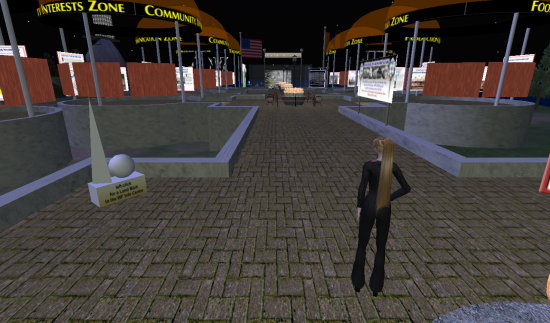When you first open up an OpenSim browser – Hippo, for example — it seems pretty straightforward. Logging in is a snap, just type your name and password. But once you log in, it’s a different story.

You start out as some faceless person in ugly clothes, although it can take a while to even get to that point if you have a slow computer or a slow connection. Moving around is simple enough, but once again, greatly hindered by the quality of your machine.
If you’re lucky enough to have a new computer, then moving around can be very easy. You use the normal arrow keys to go in a certain direction, the home key to start flying, and the page up and page down keys to control what height you’re flying at, or to jump if you aren’t flying. If you don’t, then you can still move around, it’s just a lot slower.
When you first log in to OSGrid, then you have in your inventory landmarks to various locations. Most of them are freebie shops, of varying quality. It’s easy enough to get to these locations, you just click on them and teleport, and they offer free items. These include plants and garden supplies, furniture, clothes, even hair and body types. Once you buy the clothes, you just pull up your inventory and double click on the item to put it on. You have to be careful with some items, however, because it is possible to attach them to yourself. People have been known to accidentally attach a house to themselves by double clicking it, instead of selecting it and dragging to somewhere on the ground, where a house would be normally located.
OSGrid is very useful for conferences, allowing people to attend without actually having to leave their home or office. If you’re the one holding the conference, then you first have to find a location.
You can run an OpenSim region on your own computers, rent server space, or use a public meeting location on an existing OpenSim grid. There are also groups offering free land – either for trial periods or permanent homesteading and small offices.
Once you have a location, you can put up a building, or arrange chairs in an outdoor setting. Some organizations have conferences and meetings where people stand, or walk through a facility.
However, a recognizable setting – a conference room, with chairs and tables and a coffee maker – can make newcomers feel more at home, and provide social cues as to how people are expected to act.
OSGrid and other grids have freebie stores with furniture and buildings.
Once you get a bit more experienced in OpenSim, and get comfortable using the movement controls, then you can try your hand at creating things from scratch. One of the options in the build menu is to edit terrain. You can lower and raise land, for example, to create lakes or ponds, or streams to run through or around your office space.
You can also build objects using the build tool. You start out with a block of matter in whichever three-dimensional shape you choose, and you can change the size of it to match what you want. For example, you could make a chair by starting with two flattened cubes, which you can rotate into the position you want, and then create long, narrow ones for the legs. This can be tricky to get the hang of at first, but the more you practice the more complicated the objects you can attempt.
Once you create an object, you can paint the outside of it to look like wood, metal, bricks or any other texture, by uploading photographs. There are also free texture libraries on OpenSim grids.
Making objects move requires scripting skills, though some free scripts are available as well. OpenSim scripts use the same scripting language as those in Second Life, and there are many tutorials available for people interested in learning how to use them, as well as in-world classes in Second Life.
- Firestorm opens office in OSGrid - October 17, 2012
- 5 ways to use achievements for viral marketing - September 12, 2012
- Cloud Party is a social platform, not a business venue - June 21, 2012
